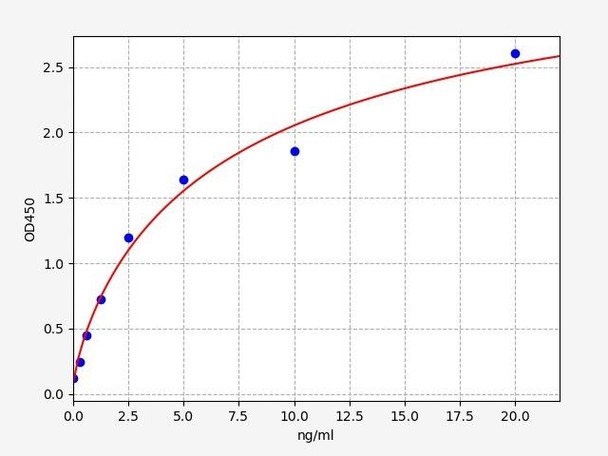Description
Mouse ADORA2A/Adenosine Receptor A2a protein ELISA Kit
The Mouse Adora2a (Adenosine Receptor A2A) Protein ELISA Kit is a specialized assay designed for the precise measurement of Adenosine Receptor A2A levels in mouse serum, plasma, and cell culture supernatants. This kit offers exceptional sensitivity and specificity, ensuring highly accurate and reproducible results for a variety of research applications.Adenosine Receptor A2A is a key protein involved in mediating the effects of adenosine signaling, playing critical roles in regulating various physiological processes such as immune response, neurotransmission, and inflammation.
Dysregulation of Adenosine Receptor A2A has been implicated in a range of diseases including cancer, neurodegenerative disorders, and inflammatory conditions, making it a valuable biomarker for investigating these diseases and developing targeted therapies.Trust in the Mouse Adora2a (Adenosine Receptor A2A) Protein ELISA Kit for your research needs, and unlock new insights into the role of Adenosine Receptor A2A in health and disease.
| Product Name: | Mouse ADORA2A/Adenosine Receptor A2a protein ELISA Kit |
| Product Code: | MOFI00370 |
| Size: | 96 Assays |
| Alias: | Adora2a, Adenosine receptor A2a |
| Detection Method: | Sandwich ELISA |
| Application: | This immunoassay kit allows for the in vitro quantitative determination of Mouse Adora2a concentrations in serum plasma and other biological fluids. |
| Sensitivity: | 0.188ng/ml |
| Range: | 0.313-20ng/ml |
| Storage: | 4°C for 6 months |
| Note: | For Research Use Only |
| Recovery: | Matrices listed below were spiked with certain level of Mouse Adora2a and the recovery rates were calculated by comparing the measured value to the expected amount of Mouse Adora2a in samples. | ||||||||||||||||
| |||||||||||||||||
| Linearity: | The linearity of the kit was assayed by testing samples spiked with appropriate concentration of Mouse Adora2a and their serial dilutions. The results were demonstrated by the percentage of calculated concentration to the expected. | ||||||||||||||||
| |||||||||||||||||
| Intra Assay: | CV <8% | ||||||||||||||||
| Inter Assay: | CV <10% |
| Component | Quantity | Storage |
| ELISA Microplate (Dismountable) | 8-12 strips | 4°C for 6 months |
| Lyophilized Standard | 2 | 4°C/-20°C |
| Sample/Standard Dilution Buffer | 20ml | 4°C |
| Biotin-labeled Antibody(Concentrated) | 120ul | 4°C (Protect from light) |
| Antibody Dilution Buffer | 10ml | 4°C |
| HRP-Streptavidin Conjugate(SABC) | 120ul | 4°C (Protect from light) |
| SABC Dilution Buffer | 10ml | 4°C |
| TMB Substrate | 10ml | 4°C (Protect from light) |
| Stop Solution | 10ml | 4°C |
| Wash Buffer(25X) | 30ml | 4°C |
| Plate Sealer | 5 | - |
Other materials and equipment required:
- Microplate reader with 450 nm wavelength filter
- Multichannel Pipette, Pipette, microcentrifuge tubes and disposable pipette tips
- Incubator
- Deionized or distilled water
- Absorbent paper
- Buffer resevoir
| Uniprot | Q60613 |
| UniProt Protein Function: | ADORA2A: one of several receptor subtypes for adenosine. A G-protein coupled receptor. Activation is mediated by G proteins which activate adenylyl cyclase. Abundant in basal ganglia, vasculature and platelets and it is a major target of caffeine. |
| UniProt Protein Details: | Protein type:Membrane protein, integral; Membrane protein, multi-pass; Receptor, GPCR; GPCR, family 1 Cellular Component: integral to plasma membrane; postsynaptic density; dendrite; integral to membrane; intermediate filament; endomembrane system; axolemma; presynaptic membrane; asymmetric synapse; postsynaptic membrane; membrane; cell soma; axon; presynaptic active zone; plasma membrane Molecular Function:G-protein coupled receptor activity; identical protein binding; signal transducer activity; enzyme binding; protein heterodimerization activity; type 5 metabotropic glutamate receptor binding; alpha-actinin binding; adenosine receptor activity, G-protein coupled Biological Process: response to alkaloid; positive regulation of circadian sleep/wake cycle, sleep; synaptic transmission, dopaminergic; prepulse inhibition; positive regulation of glutamate secretion; regulation of synaptic plasticity; locomotory behavior; negative regulation of caspase activity; signal transduction; vasodilation; G-protein signaling, adenylate cyclase activating pathway; positive regulation of synaptic transmission, glutamatergic; synaptic transmission, cholinergic; response to caffeine; regulation of inhibitory postsynaptic membrane potential; negative regulation of cell proliferation; negative regulation of alpha-beta T cell activation; negative regulation of locomotion; regulation of transcription, DNA-dependent; regulation of mitochondrial membrane potential; positive regulation of cAMP biosynthetic process; protein kinase C activation; negative regulation of neuron apoptosis; adenosine receptor signaling pathway; positive regulation of acetylcholine secretion; synaptic transmission, glutamatergic; eating behavior; response to amphetamine; positive regulation of synaptic transmission, GABAergic; regulation of calcium ion transport; regulation of norepinephrine secretion; membrane depolarization; G-protein coupled receptor protein signaling pathway; positive regulation of protein secretion; negative regulation of inflammatory response; negative regulation of vascular permeability; negative regulation of protein kinase activity; regulation of excitatory postsynaptic membrane potential; astrocyte activation; neurite morphogenesis |
| UniProt Code: | Q60613 |
| NCBI GenInfo Identifier: | 126517500 |
| NCBI Gene ID: | 11540 |
| NCBI Accession: | NP_033760.2 |
| UniProt Secondary Accession: | Q60613,Q2NLC1, |
| UniProt Related Accession: | Q60613 |
| Molecular Weight: | 44,971 Da |
| NCBI Full Name: | adenosine receptor A2a |
| NCBI Synonym Full Names: | adenosine A2a receptor |
| NCBI Official Symbol: | Adora2a |
| NCBI Official Synonym Symbols: | A2aR; A2AAR; AA2AR |
| NCBI Protein Information: | adenosine receptor A2a |
| UniProt Protein Name: | Adenosine receptor A2a |
| Protein Family: | Adenosine receptor |
| UniProt Gene Name: | Adora2a |
| UniProt Entry Name: | AA2AR_MOUSE |
*Note: Protocols are specific to each batch/lot. For the correct instructions please follow the protocol included in your kit.
| Step | Procedure |
| 1. | Set standard, test sample and control (zero) wells on the pre-coated plate respectively, and then, record their positions. It is recommended to measure each standard and sample in duplicate. Wash plate 2 times before adding standard, sample and control (zero) wells! |
| 2. | Aliquot 0.1ml standard solutions into the standard wells. |
| 3. | Add 0.1 ml of Sample / Standard dilution buffer into the control (zero) well. |
| 4. | Add 0.1 ml of properly diluted sample (Human serum, plasma, tissue homogenates and other biological fluids.) into test sample wells. |
| 5. | Seal the plate with a cover and incubate at 37 °C for 90 min. |
| 6. | Remove the cover and discard the plate content, clap the plate on the absorbent filter papers or other absorbent material. Do NOT let the wells completely dry at any time. Wash plate X2. |
| 7. | Add 0.1 ml of Biotin- detection antibody working solution into the above wells (standard, test sample & zero wells). Add the solution at the bottom of each well without touching the side wall. |
| 8. | Seal the plate with a cover and incubate at 37°C for 60 min. |
| 9. | Remove the cover, and wash plate 3 times with Wash buffer. Let wash buffer rest in wells for 1 min between each wash. |
| 10. | Add 0.1 ml of SABC working solution into each well, cover the plate and incubate at 37°C for 30 min. |
| 11. | Remove the cover and wash plate 5 times with Wash buffer, and each time let the wash buffer stay in the wells for 1-2 min. |
| 12. | Add 90 µL of TMB substrate into each well, cover the plate and incubate at 37°C in dark within 10-20 min. (Note: This incubation time is for reference use only, the optimal time should be determined by end user.) And the shades of blue can be seen in the first 3-4 wells (with most concentrated standard solutions), the other wells show no obvious color. |
| 13. | Add 50 µL of Stop solution into each well and mix thoroughly. The color changes into yellow immediately. |
| 14. | Read the O.D. absorbance at 450 nm in a microplate reader immediately after adding the stop solution. |
When carrying out an ELISA assay it is important to prepare your samples in order to achieve the best possible results. Below we have a list of procedures for the preparation of samples for different sample types.
| Sample Type | Protocol |
| Serum: | If using serum separator tubes, allow samples to clot for 30 minutes at room temperature. Centrifuge for 10 minutes at 1,000x g. Collect the serum fraction and assay promptly or aliquot and store the samples at -80°C. Avoid multiple freeze-thaw cycles. If serum separator tubes are not being used, allow samples to clot overnight at 2-8°C. Centrifuge for 10 minutes at 1,000x g. Remove serum and assay promptly or aliquot and store the samples at -80°C. Avoid multiple freeze-thaw cycles. |
| Plasma: | Collect plasma using EDTA or heparin as an anticoagulant. Centrifuge samples at 4°C for 15 mins at 1000 - g within 30 mins of collection. Collect the plasma fraction and assay promptly or aliquot and store the samples at -80°C. Avoid multiple freeze-thaw cycles. Note: Over haemolysed samples are not suitable for use with this kit. |
| Urine & Cerebrospinal Fluid: | Collect the urine (mid-stream) in a sterile container, centrifuge for 20 mins at 2000-3000 rpm. Remove supernatant and assay immediately. If any precipitation is detected, repeat the centrifugation step. A similar protocol can be used for cerebrospinal fluid. |
| Cell culture supernatant: | Collect the cell culture media by pipette, followed by centrifugation at 4°C for 20 mins at 1500 rpm. Collect the clear supernatant and assay immediately. |
| Cell lysates: | Solubilize cells in lysis buffer and allow to sit on ice for 30 minutes. Centrifuge tubes at 14,000 x g for 5 minutes to remove insoluble material. Aliquot the supernatant into a new tube and discard the remaining whole cell extract. Quantify total protein concentration using a total protein assay. Assay immediately or aliquot and store at ≤ -20°C. |
| Tissue homogenates: | The preparation of tissue homogenates will vary depending upon tissue type. Rinse tissue with 1X PBS to remove excess blood & homogenize in 20ml of 1X PBS (including protease inhibitors) and store overnight at ≤ -20°C. Two freeze-thaw cycles are required to break the cell membranes. To further disrupt the cell membranes you can sonicate the samples. Centrifuge homogenates for 5 mins at 5000xg. Remove the supernatant and assay immediately or aliquot and store at -20°C or -80°C. |
| Tissue lysates: | Rinse tissue with PBS, cut into 1-2 mm pieces, and homogenize with a tissue homogenizer in PBS. Add an equal volume of RIPA buffer containing protease inhibitors and lyse tissues at room temperature for 30 minutes with gentle agitation. Centrifuge to remove debris. Quantify total protein concentration using a total protein assay. Assay immediately or aliquot and store at ≤ -20 °C. |
| Breast Milk: | Collect milk samples and centrifuge at 10,000 x g for 60 min at 4°C. Aliquot the supernatant and assay. For long term use, store samples at -80°C. Minimize freeze/thaw cycles. |






